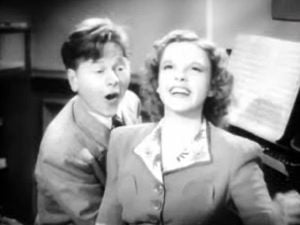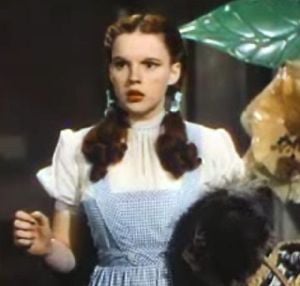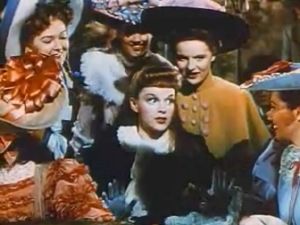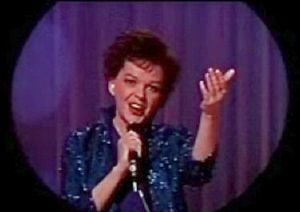Difference between revisions of "Judy Garland" - New World Encyclopedia
Cheryl Lau (talk | contribs) (New page: {{Infobox actor | bgcolour = #E9DD9D | name = Judy Garland | image = Judy Garland in A Star is Born trailer.jpg <!-- NOTE TO EDITORS: DO NOT replace Judy Garland in A Star is Born trailer....) |
Cheryl Lau (talk | contribs) |
||
| Line 1: | Line 1: | ||
| + | {{claimed}} | ||
{{Infobox actor | {{Infobox actor | ||
| bgcolour = #E9DD9D | | bgcolour = #E9DD9D | ||
Revision as of 19:38, 28 July 2007
| Judy Garland | |
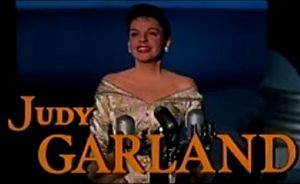 from the trailer for A Star Is Born | |
| Birth name: | Frances Ethel Gumm |
|---|---|
| Date of birth: | June 10, 1922 |
| Birth location: | Grand Rapids, Minnesota, USA |
| Date of death: | June 22 1969 (aged 47) |
| Death location: | Chelsea, London, England |
| Notable role(s): | Dorothy Gale in The Wizard of Oz Esther Smith in Meet Me in St. Louis Vicki Lester in A Star Is Born Irene Hoffman Wallner in Judgment at Nuremberg |
| Academy Awards: | Academy Juvenile Award 1940 Outstanding Performance in 1939 |
| Spouse: | David Rose (1941-1945) Vincente Minnelli (1945-1952) Sidney Luft (1952-1965) Mark Herron (1965-1967) Mickey Deans (1969) |
Judy Garland (born Frances Ethel Gumm; June 10, 1922 – June 22, 1969) was an Oscar-nominated American film actress and singer, best known for her role as Dorothy Gale from The Wizard of Oz. Garland's singing voice had a natural vibrato, which she was able to maintain at an extremely low volume. The effects which she was able to project enabled her to convey a wide range of emotion when she interpreted a song.
Biography
Childhood and early life
Born in Grand Rapids, Minnesota, Frances Ethel Gumm was the youngest child of former vaudevillians Frank Gumm and Ethel Marion Milne. Named for both her parents and baptized at the local Episcopal church, "Baby" (as Frances was affectionately called) shared the family's flair for song and dance. "Baby" Gumm's first appearance came at the age of two-and-a-half, when she joined her two older sisters, Mary Jane ("Suzy") and Dorothy Virginia ("Jimmie") on stage for a chorus of "Jingle Bells" in a Christmas show at her father's theater on December 26 1924.
In 1934, the sisters, who were touring the vaudeville circuit as "The Gumm Sisters," performed in Chicago at the Oriental Theater with George Jessel. He encouraged the group to choose a more appealing name after "Gumm" received small laughter from the audience. They settled on "The Garland Sisters," and young Frances soon afterward picked the name "Judy" after a popular song of the day by Hoagy Carmichael.
A rumor persists that Jessel came up with the last name Garland after Carole Lombard's character Lily Garland in the film Twentieth Century, which was playing at the Oriental; another rumor is that the sisters came up with the surname Garland after drama critic Robert Garland,[1] though Lorna Luft stated in her book Me and My Shadows that her mother chose the name when Jessel announced that the trio of singers "looked prettier than a garland of flowers." Still another variation would surface in 1963 when Jessel guested on Garland's television show. He claimed on air that he had sent actress Judith Anderson a telegram containing the word "garland" and it stuck in his mind; Judy agreed.
MGM
1935 - 1939
In 1935 Garland was signed to a contract with Metro-Goldwyn-Mayer, supposedly without a screen test; she had actually done a test for the studio several months earlier. Garland's first notice by studio executives came after singing an arrangement of "You Made Me Love You" to Clark Gable at a birthday party held by the studio for the actor; her rendition proved so popular that MGM placed Garland and the song in their all-star extravaganza Broadway Melody of 1938 (1937). On November 16, 1935, at the age of 13, Garland suffered a terrible blow while doing a radio performance on the Shell Chateau Hour. Her beloved father who was hospitalized with spinal meningitis, took a turn for the worse, and died November 17 (see Ancestry section below). Her song that evening was her first professional rendition of "Zing! Went the Strings of My Heart", a song which would become a standard in many of her concerts.[2]
After a string of minor roles, she landed the leading role of "Dorothy" in the MGM film The Wizard of Oz (1939) at the age of 16, and has been associated ever since with the song "Over the Rainbow." She received an honorary Academy Award for her performance in the film. After Oz, Garland became one of MGM's most bankable stars, proving particularly popular when teamed with fellow juvenile star Mickey Rooney in a string of backstage musicals. The duo first appeared together in the 1937 b-movie Thoroughbreds Don't Cry. They became a sensation and they teamed up again in Love Finds Andy Hardy, and then soon after in Babes in Arms. Garland eventually would star with Rooney in nine films.
To keep up with the frantic pace of making one film after another, Garland, Rooney, and other young performers were constantly given amphetamines, as well as barbiturates, to take before bedtime.[3] For Garland, this constant dose of drugs would lead to addiction and a lifelong struggle, as well as her eventual demise. In her later life, she would resent the hectic work and she felt that her youth was stolen from her by MGM. Despite her ability to fill concert halls worldwide, critical praise, successful film and recording careers and several awards, throughout her life she was plagued with self-doubt and required constant reassurance that she was talented.[4] Oscar Levant would later remark that "At parties, Judy could sing all night, endlessly… but when it came time to appear on a movie set, she just wouldn't show up."[5]
Garland's physical appearance created a dilemma for MGM, and she felt unattractive. At only 4 foot 11 inches, Garland's cute girl-next-door looks did not exemplify the sexy or glamorous looks required for leading ladies of the time, and her appearance caused her anxiety. As she aged, Garland went through a transformation process throughout her film career. During her early years at the studio, she was photographed and dressed in plain garments, or frilly juvenile gowns and costumes to match the girl next door image that was created for her - and also to disguise her budding figure.[6][7]
1940 - 1950
In 1940, she starred in three films; Andy Hardy Meets Debutante, Strike up the Band and Little Nellie Kelly,[8] playing her first adult role, a dual role of mother and daughter. The project was purchased from George M. Cohan as a vehicle for Garland to assess both her audience appeal and her physical appearance. The role was a challenge for the young actress requiring the use of an accent, her first adult kiss and her first (and subsequently, only) death scene.[9] The success of these three films–and a further three films in 1941– secured her position at MGM as a major property. In 1942, noticeably thinner, she was given the lead role in For Me and My Gal alongside Gene Kelly in his first screen appearance. She was top billed over the credits for the first time and effectively made the direct transition from teenage star to an adult actress.
By 1943, at the age of 21, she was finally given the "glamour treatment" in Presenting Lily Mars, in which she was dressed in "grown-up" gowns and her lightened hair was pulled-up in a stylish fashion. Years later when reflecting on her mother's film image, Liza Minnelli stated that in her opinion her mother looked "the most beautiful in this film". However, no matter how glamorous or beautiful she appeared on screen or in photographs, she was never confident in her appearance and never escaped the "girl next door" image that had been created for her.[10]
By 1944, Garland was given a new make-up artist specifically requested by Vincente Minnelli. Dorothy Ponedel refined Judy's appearance in several ways, including extending and reshaping her eyebrows, tweezing her hairline, modifying her lipline and getting rid of the unnecessary nose discs.[11] Judy appreciated the results so much that Ponedel was written into her contract for all her remaining pictures at MGM. Interestingly, MGM's attempts to "glamorize" Garland stopped in 1948, at which time her appearance was natural yet refined. Publicly, Garland stated that she was never quite happy with her appearance on screen except in Meet Me in St. Louis (1944) and The Clock (1945).
One of Garland's most successful films for MGM is the 1944 classic Meet Me in St. Louis, in which she introduced three standards: "The Trolley Song", "The Boy Next Door", and "Have Yourself a Merry Little Christmas". The Clock (1945) was her first straight dramatic film; she starred opposite Robert Walker. Though the film was critically praised and did earn a profit, most movie fans expected her to sing. Therefore, it would be many years before she acted again in a non-singing dramatic role.
Garland's other famous films of the 1940s include The Harvey Girls (1946) (in which she introduced "On the Atchison, Topeka and the Santa Fe" which was the Academy Award winning song for that year), The Pirate and Easter Parade (both 1948).
During filming for The Pirate, in April 1947, Garland suffered a nervous breakdown and had to be led away from the set.[12] After this, Garland had a number of other breakdowns that would lead to her departure from MGM; it would also reveal the emotional turmoil that Garland suffered. Two months later, Garland made her first suicide attempt.
Following her work on The Pirate, Garland would complete three more films with MGM; Easter Parade, In the Good Old Summertime, and her final film, Summer Stock. Garland was cast in the movie adaptation of Annie Get Your Gun in the title role of Annie Oakley but after various issues Garland was fired from the production and shortly thereafter removed from MGM Studios.
Renewed stardom on the stage and television
In 1951, Garland divorced Vincente Minnelli and married Sid Luft, her manager at the time. In 1952, a daughter, Lorna Luft, was born. 1951 was a milestone year for Garland and established what was to become her performing style for the rest of her life. She turned to live concert appearances and took her new act to Britain, where she played to sold out audiences throughout England, Scotland, and Ireland.[13][14] This first European tour was an enormous success, and she appeared at the famous London Palladium for the first time. Shortly afterwards, Garland appeared at New York's Palace Theatre, also for the first time. For this, she received a special Tony Award. She also appeared on various television specials during the early 1950s.
A Star Is Born
In 1954, she made a notable cinema comeback for Warner Bros. with A Star Is Born, and was nominated for Best Actress. This film is considered by many critics to be her finest performance. Directed by George Cukor and produced by her husband Sid Luft (through Garland and Luft's Transcona Enterprises), it was a large undertaking in which Garland fully immersed herself. It was also a physically demanding role that had Garland on edge and, for the most part, constantly worried. Upon its release, the film was cut by almost 30 minutes amid fears it was too long.
In the run-up to the 27th Academy Awards, Garland was believed to be the most likely winner for Best Actress. She could not attend the ceremony because she had just given birth to her son Joseph Luft; a television crew entered Garland's room with cameras and wires, in the hope that Garland would win the Best Actress award, to televise Garland's award speech. However, the Oscar went to Grace Kelly for The Country Girl (1954). Many fans hold that Garland was "robbed" of her Oscar, and should have won the award (Groucho Marx sent her a famous telegram after the awards, stating that it was "the biggest robbery since Brinks"). However she did win the Golden Globe award for Best Actress in a Musical that year.
Garland and Luft's original contract with Warner Bros. was for three pictures; however, Jack Warner was upset with cost and schedule overruns on A Star is Born, and Garland and Luft made no more films for the studio.
Carnegie Hall & television series
Although she made no other films in the 1950s, Garland's films after A Star Is Born included: Judgment at Nuremberg (1961) (for which she was nominated for Best Actress in a Supporting Role), the animated feature Gay Purr-ee (1962), A Child Is Waiting (1963, co-starring Burt Lancaster), and her final film, I Could Go On Singing (1963, co-starring Dirk Bogarde), which mirrored her own life in the story of a world famous singing star.
In November 1959, Garland was diagnosed with acute hepatitis and told that she "would never sing again".[15] However, Garland successfully recovered and returned to both films and television; her concert appearance at Carnegie Hall on April 23, 1961, was a considerable highlight, called by many "the greatest night in show business history."[16] The 2-record live recording made of the concert was a best-seller (certified gold), charting for 73 weeks on Billboard (13 weeks at number one), and won five Grammy Awards including Album of the Year and Best Female Vocal of the Year. The album has never been out of print.
After hugely successful television specials and guest appearances in the early 1960s, CBS made a $24 million offer to Garland for a weekly television series of her own, The Judy Garland Show, which was deemed at the time in the press to be "the biggest talent deal in TV history." Her television series was critically praised, but, for a variety of reasons–including the fact it was placed in the same time slot opposite Bonanza on NBC–the show lasted only one season, and went off the air in 1964, after 26 episodes. Despite this, the show won four Emmy nominations and included many notable performances by Garland. The demise of the series was personally and financially devastating for Garland, and she never fully recovered from its failure.
Her final years
With the demise of her television series, Garland returned to the stage and made various television appearances. Most notably, she performed at the London Palladium with her then 18-year-old daughter Liza Minnelli in November of 1964. The concert, which was also filmed for British station ITV, was one of Garland's final appearances at the venue. Garland, having divorced Sid Luft, continued to make concert appearances and also appeared on television specials. She made guest appearances on the The Ed Sullivan Show, The Tonight Show, The Hollywood Palace, The Merv Griffin Show (of which she guest-hosted an episode) and many others.
A 1964 tour of Australia was largely disastrous. Although the reviews for the Sydney concert were positive,[17] she could no longer hide the effects of alcohol and medication abuse. She forgot the lyrics to songs, slurred some lines which she remembered, and it was obvious she was ill or under the influence of medication. The Melbourne performance ended after only twenty minutes and created significant bad press for Garland.[18]
In February 1967, Garland was signed to appear as "Helen Lawson" in Valley of the Dolls for 20th Century Fox. The character of "Neely O'Hara" in the book by Jacqueline Susann, and subsequent movie, was rumored to have been based on Garland, though the role in the film was played by Patty Duke. During the filming, Garland missed rehearsals and was fired the next month. She was replaced by Susan Hayward. She did record one song for the film, "I'll Plant My Own Tree," which has never been officially released, although it is available on several bootlegs. There is also surviving footage of her wardrobe tests. Barbara Parkins, one of the film's stars, commented in the 2006 DVD of Valley of the Dolls that she believed Garland was frightened by the thought of actually being the aging star she was supposed to play, and that she "freaked" when she realized the similarities between the storyline and her own life.[citation needed]
Returning to the stage, Garland made her last appearances at New York's Palace Theatre in July, a sixteen-show tour, performing with her children Lorna and Joey Luft. Garland wore a sequined pants-suit onstage for this tour, which was part of the original wardrobe for her character in Valley of the Dolls.
By early 1969, Garland's health had deteriorated rapidly. She performed in London, at the Talk of the Town nightclub for a five-week run, and made her last concert appearance in Copenhagen during March 1969.
Death
The shortcomings of Garland's childhood years became more apparent as she struggled to overcome various personal problems, including weight gain, weight loss, and serious drug addiction. She was found dead in her London home, in her bathroom by her last husband, Mickey Deans, on June 22, 1969. The stated exact cause of death by coroner Gavin Thursdon was accidental overdose of barbiturates; her blood contained the equivalent of 10 1.5-grain Seconal capsules.[19] Garland had turned 47 just over a week prior to her death. She was residing in a rented house with her husband in the Chelsea area of London at the time of her death.
At Garland's funeral, The Wizard of Oz co-star Ray Bolger commented, "She just plain wore out."[20] Garland is interred in Ferncliff Cemetery, in Hartsdale, New York.[21]
Marriages
Of Garland's five marriages, the first four ended in divorce. Her children are Liza Minnelli (singer and actress) born March 1946, Lorna Luft (also an acclaimed singer), born November 21, 1952, and Joey Luft (a scenic photographer), born March 29, 1955 in Los Angeles, California.
- David Rose; married 1941-1945
- Vincente Minnelli; married 1945-1952; one daughter, Liza Minnelli
- Sidney Luft; married 1952-1965; one daughter, Lorna Luft, and one son, Joey Luft
- Mark Herron; married 1965-1967
- Mickey Deans; married March 1969-June 1969
Ancestry
Garland’s family tree[22] can be traced back to the early colonization of the United States (on both her paternal and maternal family lines).
Her earliest paternal ancestor was George Marable (1631 - 1683), who traveled to Virginia from Kent, England, circa 1652 and was one of the first colonists settling in what is now Jamestown, Virginia. The Marable families[23] of the southern United States all derived from the aforementioned George Marable.[24]
The Marable family were wealthy southern aristocracy and as such were slave owners. By the time of the Civil War, the Marable family of Jamestown, Virginia, had spread across the South. Marables are named in the rosters of units from at least nine of the Confederate States including units from Tennessee, Georgia, Alabama and Mississippi, and were among the dead at Gettysburg. In Virginia, Edward W. Marable of the Charles City Southern Guard served aboard the Confederate ship Patrick Henry during the engagement of the Merrimack (C.S.S. Virginia) with the Federal fleet at Hampton Roads. John H. Marable of the 13th Virginia Cavalry served as a courier for Gen. J. E. B. Stuart.[25]
It is from Benjamin Marable (1710 - 1773), who traveled to Tennessee, that the Gumm family is descended. The Gumm name can also be found in the registers of soldiers who fought for the Confederacy throughout Rutherford County, Tennessee.[26]
Garland's father was Francis Avent Gumm, the fourth of six children born in Murfreesboro, Tennessee on March 20 1886. He died on November 17 1935, in Los Angeles, California. His parents were William Tecumseh Gumm (1854 - 1906) and Elizabeth Clemmie Baugh (1857 - 1895). The Gumm family was a mixture of English, Irish, Scottish, French Huguenot and German.[27]
Frank Gumm married Ethel Marian Milne, who was born on November 17 1893 in Michigamme, Michigan. She died January 5 1953 in Los Angeles, California. Ethel was the eldest of eight children born to Eva Fitzpatrick (born on January 4 1865 in Messina, New York) and John Milne (born October 15 1865 in Ontario Canada). His parents were Charles Milne (born in 1829 in Arbroath Scotland) and Mary Kelso (born 1837 in Kilmarnock Scotland)[28] (reference: The Golden Years by Rita Piro).
Eva Fitzpatrick-Milne was the daughter of Hugh Fitzpatrick (1838 - 1908), whose family arrived in the United States from Smithtown, County Meath, Ireland in the 1770s and Mary-Elizabeth Harriot (born December 23 1841 in Dublin, Ireland). Mary, one of thousands of orphans as a result of the Irish Famine, was raised in a Dublin convent.[29] In 1858, at the age of 17, she married Hugh Fitzpatrick (an Irish-American) who was visiting Dublin. That same year, the newlyweds sailed to America. They had ten children. Mary died on January 24 1908 in Detroit, Michigan. The Fitzpatrick family fought on the side of the British during the Revolutionary War and as a result, Peter Fitzpatrick (1752 - 1812) son of Patrick Fitzpatrick (1727) was sentenced to be hanged as a spy, but this was not carried out and the family moved across the border into Canada;[30] (reference: The Golden Years by Rita Piro).
Eva Fitzpatrick-Milne lived with Judy Garland until her death on October 17 1949 at the age of 84. She is buried with Garland's father in Forest Lawn Cemetery, Glendale CA. Garland's mother is also buried nearby in a separate grave[31] (reference: The Golden Years by Rita Piro).
A family link between Garland and the 18th United States President Ulysses S Grant has often been incorrectly stated. Garland’s great, great grandfather Hugh Fitzpatrick (1809 - 1878) was married twice; his second wife was Catherine Grant, a first cousin of Grant. However, Garland is descended from a son, also named Hugh (born 1838), from his first wife (Margaret Ross, 1807 - 1845), therefore there is no blood link.[32]
When commenting on her ancestry, Garland described herself as Irish and Scottish and referred to herself during a 1963 press conference as "just an Irish biddy".[33] In her autobiography Lorna Luft states that her family had an "Irish charm" and that "often the family survived on charm alone".[34]
See also
- List of Judy Garland performances
- Judy Garland Honors
ReferencesISBN links support NWE through referral fees
- ↑ Judy: Beyond the Rainbow, A&E/Biography television special
- ↑ http://www.jgdb.com/radio35.htm The Judy Garland Database, Judy Garland on Radio - 1935 Listing, Jim Johnson
- ↑ "Judy Garland: By Myself" in the American Masters series on PBS
- ↑ Clarke, Gerald, Get Happy-The Life of Judy Garland,ISNB -075-6761-31-X, pages 131-135
- ↑ Oscar Levant, The Unimportance of Being Oscar, Pocket Books 1969 (reprint of G.P. Putnam 1968), p. 35. ISBN 0-671-77104-3.
- ↑ Frank, Gerold, Judy, ISBN 0-306-80894-3, pages 71,72
- ↑ Clarke, Gerald, Get Happy-The Life of Judy Garland,ISNB -075-6761-31-X, page 131
- ↑ Still Irish: a Century of Irish in film, Kevin Rockett and Eugene Finn, Dublin Red Mountain Press, 1995 ISBN 1-900361-00-0. contains analysis of Garland's impact and persona as well as many photographs during her Hollywood career
- ↑ Judy Garland: A Portrait in Art & Anecdote, John Fricke, Bullfinch, 2003
- ↑ Clarke, Gerald, Get Happy-The Life of Judy Garland,ISNB -075-6761-31-X, page 131
- ↑ Minnelli, Vincente, I Remember it Well, 1974, Doubleday, ISBN 057-3606-072—>
- ↑ 1946-1950 Timelines, The Judy Room (Accessed June 30, 2006)
- ↑ Frank, Gerold, Judy, ISBN 0-306-80894-3, pages 325-327
- ↑ http://users.deltacomm.com/rainbowz/inconcert_1951.html Users/deltacomm.com
- ↑ http://www.thejudyroom.com/timeline4.html Thejudyroom.com
- ↑ http://www.variety.com/article/VR1117944197.html?categoryId=1228&cs=1
- ↑ http://users.deltacomm.com/rainbowz/con051364.html Users.deltacomm.com
- ↑ http://users.deltacomm.com/rainbowz/con052064.html Users.deltacomm.com
- ↑ Thomson, David,Film Studies: She couldn't act for toffee - until she burst into song; The Independent; 2004-06-27; Retrieved on 2007-01-26
- ↑ End of the rainbow, Time Magazine, 1969
- ↑ http://partners.nytimes.com/books/00/04/09/specials/garland-view.html Partners.nytimes.com
- ↑ http://www.genealogy.com/famousfolks/liza-minnelli/ Genealogy.com
- ↑ Of Garland's five marriages, the first four ended in divorce. Her children are Liza Minnelli (singer and actress) born March 1946, Lorna Luft (also an acclaimed singer), born November 21, 1952, and Joey Luft (a scenic photographer), born March 29, 1955 in Los Angeles, California. David Rose; married 1941-1945 Vincente Minnelli; married 1945-1952; one daughter, Liza Minnelli Sidney Luft; married 1952-1965; one daughter, Lorna Luft, and one son, Joey Luft Mark Herron; married 1965-1967 Mickey Deans; married March 1969-June 1969 http://www.marable-family.net/jlmarable/ Marable-family.net
- ↑ Marable Family History http://www.marable-family.net/jlmarable/
- ↑ Marable Family History http://www.marable-family.net/jlmarable/
- ↑ Piro, Rita, Judy Garland: The Golden Years, ISBN 0-9706261-7-7
- ↑ Clarke, Gerald, Get Happy-The Life of Judy Garland,ISNB -075-6761-31-X<
- ↑ Piro, Rita, Judy Garland: The Golden Years, ISBN 0-9706261-7-7
- ↑ Frank, Gerold, Judy, ISBN 0-306-80894-3, page 31
- ↑ Piro, Rita, Judy Garland: The Golden Years, ISBN 0-9706261-7-7
- ↑ Piro, Rita, Judy Garland: The Golden Years, ISBN 0-9706261-7-7
- ↑ Piro, Rita, Judy Garland: The Golden Years, ISBN 0-9706261-7-7
- ↑ Frank, Gerold, Judy, ISBN 0-306-80894-3
- ↑ Luft, Lorna, Me and My Shadows: A Family Memoir, 1998, Simon and Schuster, ISBN 0-283-06320-3 (1999, Pocket Books paperback edition, ISBN 0-671-01900-7) —>
External links
- Judy Garland at the Internet Movie Database
- Judy Garland at the TCM Movie Database
- Judy Garland at the Internet Broadway Database
- Judy Garland Page On The Oldies Music Guide
- Judy Garland On The Oldies Radio Station
- Judy Garland at HighBeam
- The Judy Garland Database
- The Judy Room
- The Judy Garland Online Discography
- The Judy Garland Birthplace and Museum in Grand Rapids, MN
- The Judy Garland Club: established 1963; official international Club supported by Judy during her lifetime
- Judy Garland - The Live Performances
- Judy Garland: By Myself - American Masters special
- Judy Garland at TV.com
| Awards | ||
|---|---|---|
| Preceded by: Deanna Durbin, Mickey Rooney |
Academy Juvenile Award 1939 |
Succeeded by: Margaret O'Brien |
| Preceded by: Ruth Green |
Special Tony Award 1952 |
Succeeded by: Beatrice Lillie, Danny Kaye |
| Preceded by: Ethel Merman for Call Me Madam |
Golden Globe Award for Best Actress - Motion Picture Musical or Comedy 1954 for A Star Is Born |
Succeeded by: Jean Simmons for Guys and Dolls |
| Preceded by: Fred Astaire |
Cecil B. DeMille Award 1962 |
Succeeded by: Bob Hope |
| Preceded by: Bob Newhart for The Button-Down Mind of Bob Newhart |
Grammy Award for Album of the Year 1962 for Judy at Carnegie Hall |
Succeeded by: Vaughn Meader for The First Family |
| Preceded by: Ella Fitzgerald for Ella in Berlin: Mack the Knife |
Grammy Award for Best Vocal Performance, Female 1962 for Judy at Carnegie Hall |
Succeeded by: Ella Fitzgerald for Ella Swings Brightly with Nelson |
| Preceded by: Dave Brubeck, Marvin Gaye, Georg Solti, Stevie Wonder |
Grammy Lifetime Achievement Award 1997 |
Succeeded by: Bo Diddley, The Mills Brothers, Roy Orbison, Paul Robeson |
| Songwriters |
|
Arlen | Berlin | Blane | Cahn | Carmichael | Coleman | Dietz | Ellington | Fain | Fields | G. Gershwin | I. Gershwin | Hammerstein | Hart | Kern | Lerner | Loewe | Loesser | Mancini | Mandel | Martin | Mercer | McHugh | Porter | Rodgers | Schwartz | Styne | Webster |
| Singers |
|
Anka | Armstrong | Astaire | Bennett | Boswell | Boswells | Brice | Bublé | Carter | Clooney | Cole | Como | Connick | Crosby | Day | Dearie | Eckstine | Faye | Feinstein | Fitzgerald | Francis | Garland | Holiday | Horn | Horne | Keel | Kelly | Krall | Laine | Lamour | Lee | Manilow | Martin | Mathis | McRae | Midler | Nilsson | Page | Rogers | Shore | Simone | Sinatra | Stafford | Stewart | Streisand | Tormé | Vaughan | Washington | Williams |
Credits
New World Encyclopedia writers and editors rewrote and completed the Wikipedia article in accordance with New World Encyclopedia standards. This article abides by terms of the Creative Commons CC-by-sa 3.0 License (CC-by-sa), which may be used and disseminated with proper attribution. Credit is due under the terms of this license that can reference both the New World Encyclopedia contributors and the selfless volunteer contributors of the Wikimedia Foundation. To cite this article click here for a list of acceptable citing formats.The history of earlier contributions by wikipedians is accessible to researchers here:
The history of this article since it was imported to New World Encyclopedia:
Note: Some restrictions may apply to use of individual images which are separately licensed.
